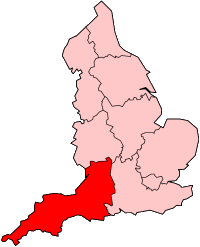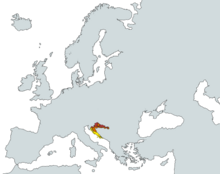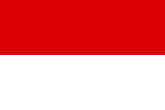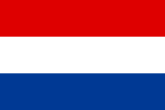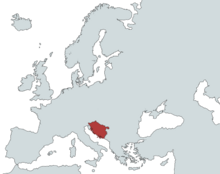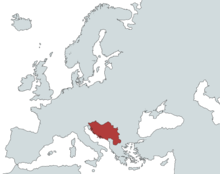| Year |
Date |
Event
|
| 1903 |
27 June |
Ban Khuen-Héderváry resigned to become the Hungarian Prime Minister.
|
|
Teodor Pejačević was appointed Ban.
|
| 1907 |
26 June |
Aleksandar Rakodczay became Ban.
|
| 1908 |
8 January |
Pavao Rauch was appointed Ban.
|
| 27 February |
Croatian parliamentary election, 1908: The first day of balloting was held.
|
| 28 February |
Croatian parliamentary election, 1908: The second day of balloting was held. The Croat-Serb Coalition won a majority of seats in the Sabor.
|
| 12 March |
Rauch dissolved the Sabor.
|
| 1910 |
5 February |
Rauch was dismissed and replaced as Ban by Nikola Tomašić.
|
| 28 October |
Croatian parliamentary election, 1910: The Croat-Serb Coalition won a plurality of seats in the Sabor.
|
| 1912 |
19 January |
Slavko Cuvaj was appointed Ban.
|
| 1913 |
21 July |
Ivan Škrlec was appointed Ban.
|
| 16 December |
Croatian parliamentary election, 1913: The first day of balloting was held.
|
| 17 December |
Croatian parliamentary election, 1913: The second day of balloting was held. The Croat-Serb Coalition won a majority of seats in the Sabor.
|
| 1914 |
28 June |
Assassination of Archduke Franz Ferdinand of Austria: Archduke Franz Ferdinand of Austria was assassinated by Gavrilo Princip of the Bosnian separatist group Young Bosnia.[citation needed]
|
| 23 July |
July Crisis: Austria-Hungary issued an ultimatum to Serbia, demanding, among other things, the right to participate in the investigation into the assassination of Franz Ferdinand, which Serbia refused.[citation needed]
|
| 28 July |
World War I: Austria-Hungary declared war on Serbia.
|
| 30 July |
World War I: Russia mobilized its army to defend Serbia.
|
| 1915 |
|
Škrlec reconvened the Sabor.
|
| 26 April |
World War I: The secret Treaty of London (1915) was signed, under which Russia, France and the United Kingdom recognized Italian territorial claims (including some in Croatia) in return for Italy's joining the war on the side of the Triple Entente.[citation needed]
|
| 1916 |
21 November |
Franz Joseph I of Austria died. He was succeeded as king by his grandnephew Charles I of Austria.
|
| 1917 |
29 June |
Skerlecz resigned. Antun Mihalović became Ban.
|
| 1918 |
29 October |
The Sabor dissolved Croatia's union with Austria-Hungary and incorporated the Kingdom of Dalmatia into the new State of Slovenes, Croats and Serbs.
|
| 1 December |
The State of Slovenes, Croats and Serbs joined with Serbia to form the new Kingdom of Yugoslavia under King Peter I of Serbia.
|
| 1919 |
20 January |
Mihalović left office.
|
| 1920 |
12 November |
Yugoslavia signed the Treaty of Rapallo (1920), acceding to Italian claims on some of its territory.
|
| 28 November |
Kingdom of Serbs, Croats and Slovenes Constitutional Assembly election, 1920: The Democratic Party, People's Radical Party and Communist Party were the three most successful parties by number of seats received in the Assembly.
|
| 29 December |
The government issued a decree banning Communist propaganda and ordering the dissolution of all Communist organizations until approval of the Constitution.
|
| 1921 |
28 June |
The Vidovdan Constitution, which abolished the traditional divisions of the region in favor of thirty-three oblasts ruled by royal appointees, was approved.
|
| 16 August |
Peter died. He was succeeded as king by his son Alexander I of Yugoslavia.
|
| 1923 |
18 March |
Kingdom of Serbs, Croats and Slovenes parliamentary election, 1923: The People's Radical Party won a plurality of seats in Parliament.
|
| 1925 |
8 February |
Kingdom of Serbs, Croats and Slovenes parliamentary election, 1925: The People's Radical Party won a plurality of seats in Parliament.
|
| 1927 |
11 September |
Kingdom of Serbs, Croats and Slovenes parliamentary election, 1927: The People's Radical Party won a plurality of seats in Parliament.
|
| 1928 |
20 June |
Puniša Račić of the People's Radical Party shot five members of the Croatian Peasant Party (HSS) during a session of Parliament. Two were killed instantly, and Party leader Stjepan Radić was fatally wounded.
|
| 8 August |
Radić died.
|
| 1929 |
6 January |
6 January Dictatorship: Alexander issued a decree dissolving Parliament and abolishing the Constitution.
|
| 3 October |
Alexander replaced the thirty-three oblasts with nine banovinas.
|
| 1931 |
3 September |
6 January Dictatorship: Alexander issued the 1931 Yugoslav Constitution, ending the dictatorship.
|
| 1934 |
9 October |
Alexander was assassinated by a Bulgarian mercenary, Vlado Chernozemski, with the Internal Macedonian Revolutionary Organization; Chernozemski had been contracted by the Ustaše, which was formed in 1929. Alexander was succeeded by his eleven-year-old son, Peter, with his cousin, Prince Paul, leading a regency council of three.[citation needed]
|
| 1935 |
5 May |
Yugoslavian parliamentary election, 1935: The Yugoslav National Party won a majority of seats in Parliament.
|
| 1938 |
11 December |
Yugoslavian parliamentary election, 1938: The Yugoslav Radical Union won a majority of seats in Parliament.
|
| 1939 |
23 August |
The Cvetković–Maček Agreement was approved, establishing the autonomous Banovina of Croatia with an elected Sabor and a crown-appointed Ban.
|
| 26 August |
Ivan Šubašić was appointed Ban of Croatia.
|
| 1941 |
25 March |
World War II: Prince Paul signed the Tripartite Pact, pledging support to the Axis Powers.
|
| 27 March |
Yugoslav military coup of 27 March 1941: A military coup overthrew the Regency and declared Peter II to be of age.[citation needed]
|
| 6 April |
World War II in Yugoslavia begins
|
| 6 April |
Invasion of Yugoslavia: Germany opened an invasion of Yugoslavia with an air attack on Belgrade.
|
| 10 April |
Independent State of Croatia declared by Ante Pavelić of the Ustaše.
|
| 13 May |
Croatia signed a treaty establishing its borders with Germany.
|
| 18 May |
Prince Aimone, Duke of Aosta was crowned King Tomislav II of Croatia by the Italian King Victor Emmanuel III of Italy.
|
| 19 May |
Croatia ceded land, including most of Dalmatia, to Italy by signing the treaty of Rapallo.
|
| 7 June |
Croatia's borders with Serbia were established.
|
| 22 June |
Operation Barbarossa: Germany launched an invasion of the Soviet Union.
|
| 4 July |
A call by the Communist Party of Yugoslavia to resist the Ustaše government marked the birth of the Yugoslav Partisans.
|
| August |
Glina massacre: The Ustaše killed several hundred Serb civilians in a church in Glina.
|
| 27 October |
Croatia's borders with Montenegro were established.
|
| 1942 |
5 October |
Operation Alfa: Italian and Chetnik forces attacked the Partisan-held town of Prozor.
|
| 10 October |
Operation Alfa: The battle ended in a Partisan defeat.
|
| 26 November |
The Anti-Fascist Council of the People's Liberation of Yugoslavia (AVNOJ) was established as the political organization of the Yugoslav Partisans.
|
| 1943 |
15 May |
Battle of the Sutjeska: Axis troops surrounded the main Partisan force on the east bank of the Sutjeska river in Bosnia.
|
| 14 June |
The National Anti-Fascist Council of the People's Liberation of Croatia (ZAVNOH), composed of Croatian members of the AVNOJ, held its first session and declared Vladimir Nazor President.
|
| 16 June |
Battle of the Sutjeska: The Partisans escaped across the Sutjeska.
|
| 25 July |
Italian King Victor Emmanuel III of Italy dismissed his Prime Minister Benito Mussolini.
|
| 31 July |
Tomislav abdicated on the orders of the Italian King Victor Emmanuel III of Italy.
|
| 8 September |
World War II: An armistice between Italy and Allied armed forces was published, voiding Croatia's territorial concessions of 1941 and the Treaty of Rapallo (1920).
|
| 15 November |
Operation Delphin: Croatian forces undertook a campaign to capture several islands in the Adriatic Sea off the cost of central Dalmatia.
|
| 21 November |
The second session of the AVNOJ established the National Committee for the Liberation of Yugoslavia, the government-in-waiting of a federal, democratic Yugoslavia under Prime Minister Josip Broz Tito.
|
| 1 December |
Operation Delphin: The operation concluded successfully.
|
| 1944 |
9 May |
The Federal State of Croatia was established at the third session of the ZAVNOH.
|
| 13 May |
The Department for the Protection of the People (OZNA) was established under Aleksandar Ranković.
|
| 25 May |
Raid on Drvar: German paratroopers attacked Partisan headquarters near Drvar. Tito escaped.
|
| 16 June |
Tito and Šubašić signed the Treaty of Vis, which provided for a coalition of royalists and Communists in the government of the future Yugoslavia.
|
| 1945 |
30 March |
Battle on Lijevče field: Croatian and Chetnik forces met at Lijevče.
|
| 8 April |
Battle on Lijevče field: The Chetniks surrendered.
|
| 6 May |
Pavelić fled the country.
|
| 8 May |
World War II in Yugoslavia formally ends with the German Instrument of Surrender, but fighting continues.
|
| 14 May |
Battle of Poljana: Retreating Axis troops were forced to surrender to the Partisans.
|
| 15 May |
Bleiburg repatriations: After the retreating Axis column is stopped at Bleiburg, Austria, and forced by the British Army to surrender instead to the Yugoslav Partisans,[35] the Yugoslav Partisans commit thousands of reprisals against the remnants of the Ustaše and the civilians who fled Croatia alongside them, as well as some Slovene, Serb, and Montenegrin collaborators.
|
| 10 June |
Tito agreed to the separation of Allied and Partisan forces at the Morgan Line.
|
| 21 August |
ZAVNOH declared itself the People's Parliament of Croatia.
|
| 25 August |
The People's Parliament elected Nazor President of Croatia.
|
| October |
The royalists in the Yugoslavian government resigned.
|
| 11 November |
The Communist Party won an overwhelming majority of votes to the Constituent Assembly of Yugoslavia.
|
| 29 November |
The Federal People's Republic of Yugoslavia was declared and King Peter deposed.
|
| 1946 |
31 January |
The 1946 Yugoslav Constitution came into force.
|
| 1947 |
10 February |
The Paris Peace Treaties, 1947 were signed, solidifying Yugoslavia's border with Italy and establishing the Free Territory of Trieste, half of which was to be under Yugoslavian military occupation.[citation needed]
|
| September |
The Cominform was established.
|
| 1948 |
May |
Tito–Stalin split: Croatian Communist Party member Andrija Hebrang was arrested after supporting the Soviet Union in a dispute with Yugoslavia.[citation needed]
|
| 28 June |
Tito–Stalin split: Yugoslavia was expelled from the Cominform.
|
| 1949 |
19 June |
Nazor died.
|
| 1950 |
26 June |
Tito announced the introduction of workers' self-management in Yugoslavia.
|
| 1953 |
13 January |
The 1953 Yugoslav Constitution came into force.
|
| December |
Vladimir Bakarić became President of Croatia.
|
| 1963 |
7 April |
The 1963 Yugoslav Constitution came into force.
|
| 1967 |
13 March |
Croatian Spring: The Declaration on the Status and Name of the Croatian Literary Language was published, demanding equal status for the Croatian language.
|
| 1971 |
23 November |
Croatian Spring: A student protest began in Zagreb.
|
| December |
Croatian Spring: Tito forced Chair of the Croatian Communist Party Savka Dabčević-Kučar to resign.
|
| 1974 |
21 February |
The 1974 Yugoslav Constitution came into force, establishing a nine-member Presidency of Yugoslavia of which Tito was president for Life.
|
| April |
Ivo Perišin became President of Croatia.
|
| 8 May |
Perišin was succeeded by a rotating Croatian Presidency under the 1974 Yugoslav Constitution.
|
| 1975 |
10 November |
The Treaty of Osimo was signed, under which Italy and Yugoslavia were allowed to annex their respective occupation zones in Trieste.
|
| 1980 |
4 May |
Tito died. He was succeeded as President of the Presidency of Yugoslavia by the Macedonian Lazar Koliševski.
|
| 15 May |
The Yugoslavian Presidency rotated to the Bosnian Cvijetin Mijatović.
|
| 1981 |
15 May |
The Yugoslavian Presidency rotated to the Slovenian Sergej Kraigher.
|
| 1982 |
15 May |
The Yugoslavian Presidency rotated to the Serbian Petar Stambolić.
|
| 1983 |
15 May |
The Yugoslavian Presidency rotated to the Croatian Mika Špiljak.
|
| 1984 |
15 May |
The Yugoslavian Presidency rotated to the Montenegrin Veselin Đuranović.
|
| 1985 |
15 May |
The Yugoslavian Presidency rotated to the Vojvodin Radovan Vlajković.
|
| 1986 |
10 May |
Ante Marković assumed the Presidency of Croatia.
|
| 15 May |
The Yugoslavian Presidency rotated to the Kosovar Sinan Hasani.
|
| 1987 |
15 May |
The Yugoslavian Presidency rotated to the Macedonian Lazar Mojsov.
|
| 1988 |
15 May |
The Yugoslavian Presidency rotated to the Bosnian Raif Dizdarević.
|
| 1989 |
15 May |
The Yugoslavian Presidency rotated to the Slovenian Janez Drnovšek.
|
| 1990 |
23 January |
A Communist Party Congress ended the party's legal monopoly in Croatia.
|
| 22 April |
Croatian parliamentary election, 1990: The first round of elections was held.
|
| 6 May |
Croatian parliamentary election, 1990: The second round of elections was held. The Croatian Democratic Union (HDZ) won a majority of seats in all houses of Parliament.
|
| 15 May |
The Yugoslavian Presidency rotated to the Serbian Borisav Jović.
|
| 30 May |
The Serb Democratic Party (SDS) quit the Croatian Parliament.
|
| 25 July |
A Serbian Assembly led by the SDS declared the establishment of the Serbian Autonomous Oblast of Kninska Krajina.
|
| 17 August |
Log Revolution: Secessionist Serbs barricaded roads connecting Kninska Krajina to the rest of Croatia.
|
| October |
Kninska Krajina was superseded by the larger Serbian Autonomous Oblast of Krajina.
|
| 22 December |
The current Constitution of Croatia was ratified. Franjo Tuđman of the HDZ was made President of Croatia.
|
| 1991 |
2 March |
Pakrac clash: Croatian police arrested 180 Serb rebels who had occupied the town of Pakrac.
|
| 25 March |
Presidents of Croatia and Serbia partake in the Milošević–Tuđman Karađorđevo meeting
|
| 31 March |
Plitvice Lakes incident: Croatian police entered the Plitvice Lakes National Park to expel the secessionist forces of Krajina. Two combatants were killed.
|
| 1 April |
Plitvice Lakes incident: The Yugoslavian army intervened to end the crisis.
|
| 1 May |
Two Croatian police officers were taken prisoner by Serb secessionists in Borovo Selo.
|
| 2 May |
The Croatian Parliament voted to hold a referendum on independence from Yugoslavia.
|
| Borovo Selo killings: An attempt to free the captives resulted in a firefight between Serb rebels and police. Twelve Croatian policemen killed, with an unknown number of rebel casualties.
|
| 15 May |
Serbia blocked the accession of Croatian Stjepan Mesić to the Yugoslavian Presidency.
|
| 19 May |
Croatian independence referendum, 1991: Croatian independence from Yugoslavia was approved in referendum, with 93% support.
|
| 25 June |
The Croatian Parliament declared Croatia independent from Yugoslavia.
|
| Serb secessionists declared the Serbian Autonomous Oblast of Eastern Slavonia, Baranja and Western Syrmia.
|
| July |
Battle of Osijek: JNA forces began shelling the town of Osijek.
|
| 15 July |
Operation Coast-91: JNA and SAO Krajina forces attacked the town of Biograd but were rebuffed.
|
| August |
Operation Opera Orientalis: Yugoslavian intelligence bombed Jewish cemeteries in an attempt to turn international opinion against Croatian independence.
|
| 1 August |
Dalj massacre: Serb rebels killed twenty-eight police officers and eleven Croat civilians in Dalj.
|
| 12 August |
Serb secessionists declared the Serbian Autonomous Oblast of Western Slavonia.
|
| 25 August |
Battle of Vukovar: The Yugoslavian army and Serb militias laid siege to the town of Vukovar.
|
| 9 September |
Battle of the Barracks: The Yugoslavian barracks in Sisak surrendered to Croatian forces.
|
| 16 September |
Battle of Šibenik (1991): The Yugoslavian army attacked Croatian forces in Šibenik.
|
| 22 September |
Battle of Šibenik (1991): Yugoslavian forces were made to retreat.
|
| 1 October |
Siege of Dubrovnik: Yugoslavian forces surrounded Dubrovnik.
|
| 6 October |
Operation Coast-91: A truce was agreed.
|
| 7 October |
Bombing of Banski dvori: The Yugoslavian army bombed the government residence, the Banski dvori in Zagreb.
|
| 13 October |
Široka Kula massacre: Serb forces killed thirty-four civilians.
|
| 16 October |
Gospić massacre: A three-day massacre began during which Serb forces killed between twenty-three and one hundred civilians.
|
| 18 October |
Lovas massacre: Serbs forced a group of Croat civilians to walk across a minefield, killing twenty-one.
|
| 21 October |
Baćin massacre: Serb rebel forces killed some fifty-six civilians.
|
| 31 October |
Operation Otkos 10: Croatian forces moved to block a Yugoslavian advance on Zagreb.
|
| 4 November |
Operation Otkos 10: The operation concluded successfully.
|
| 10 November |
Erdut massacre: Serb rebels executed the first ten of the thirty-seven Hungarian and Croat civilians they would eventually massacre in Erdut.
|
| 12 November |
Saborsko massacre: Serb rebel forces killed twenty-nine civilians in Saborsko.
|
| 14 November |
Battle of the Dalmatian channels: A Yugoslavian ship was sunk by the Croatian navy near Split.
|
| 16 November |
Battle of the Dalmatian channels: The Yugoslavian blockade of Split was broken.
|
| 18 November |
Battle of Vukovar: The last Croatian forces surrendered.
|
| Škabrnja massacre: Serb forces took the town of Škabrnja and began a massacre which would eventually claim eighty-six lives.
|
| Bosnian War: The Croatian Democratic Union of Bosnia and Herzegovina (HDZBiH) established Croatian Community of Herzeg-Bosnia at municipalities with majority of Croatian people on the territory of Bosnia and Herzegovina.
|
| 20 November |
Vukovar massacre: Some 264 civilians, mostly Croats, were murdered by Serb militias near Vukovar.
|
|
|
| 12 December |
Operation Orkan 91 The Croatian Army began an advance into Krajina.
|
| Operation Whirlwind: The Croatian army attempted to cross the Kupa river against Krajina forces.
|
| 13 December |
Voćin massacre: A Serb paramilitary group, the White Eagles, killed several dozen people before retreating from Voćin.
|
| Operation Whirlwind: The Croatian advance was stopped.
|
| 16 December |
Joševica massacre: Serb forces killed twenty-one civilians in Joševica.
|
| 19 December |
Krajina declared independence from Croatia, proclaiming itself the Republic of Serbian Krajina.
|
| 21 December |
Bruška massacre: Serb forces killed ten civilians in Bruška.
|
| 1992 |
2 January |
Operation Orkan 91: A ceasefire was negotiated.
|
| Battle of Osijek: A ceasefire was negotiated.
|
| 26 February |
Krajina invested SAO Eastern Slavonia, Baranja and Western Syrmia and Western Slavonia.
|
| 6 May |
Bosnian War: The Graz agreement was drafted, delineating the demarcation between Herzeg-Bosnia and the Republika Srpska in Bosnia and Herzegovina.
|
| 26 May |
Siege of Dubrovnik: Croatian forces broke the siege.
|
| June |
Operation Vrbas '92: Military offensive of the Army of Republika Srpska against the HVO and ARBiH in Jajce.
|
| 14 June |
Operation Corridor: The Army of Republika Srpska launched an offensive against the joint forces of Bosnia and Herzegovina, Croatia and Herzeg-Bosnia.
|
| 21 June |
Miljevci plateau incident: Croatian forces captured some thirty square miles in a surprise attack on Krajina forces.
|
| 26 June |
Operation Corridor: The operation ended with the successful linking of the two parts of Republika Srpska.
|
| 2 August |
Croatian parliamentary election, 1992: The HDZ won a majority of seats in the Sabor.
|
| Croatian presidential election, 1992: Tuđman was reelected with 57% of the vote.
|
| 12 August |
Hrvoje Šarinić of the HDZ was elected prime minister.
|
| 18 October |
Croat–Bosniak War: First armed clashes between the Croatian Defence Council (HVO) and the Army of the Republic of Bosnia and Herzegovina (ARBiH).
|
| 27 October |
Operation Vrbas '92: The operation concluded with the conquest of Jajce.
|
| 1993 |
22 January |
Operation Maslenica: The Croatian army launched an offensive to reconquer Krajina territory in northern Dalmatia.
|
| 1 February |
Operation Maslenica: The Croatian government halted the offensive.
|
| September |
Operation Neretva '93: ARBiH forces attack the HVO in Herzegovina and central Bosnia.
|
| 9 September |
Operation Medak Pocket: Croatian forces launched a southeastward offensive against Krajina towards the village of Medak.
|
| 17 September |
Operation Medak Pocket: Croatia negotiated a ceasefire under international pressure.
|
| 1994 |
23 February |
Croat–Bosniak War: The war was effectively ended with a ceasefire.
|
| 18 March |
Croat–Bosniak War: The Washington Agreement was signed, establishing the Federation of Bosnia and Herzegovina within Bosnia and Herzegovina.
|
| 29 November |
Operation Winter '94: Croatian forces launched an offensive into western Bosnia and Herzegovina.
|
| 24 December |
Operation Winter '94: The offensive ended to Croatian territorial advantage.
|
| 1995 |
1 May |
Operation Flash: The Croatian Army launched an offensive which would reconquer the territory of the former Western Slavonia in Krajina.
|
| 2 May |
Zagreb rocket attacks: A two-day series of rocket attacks by Serb forces on Zagreb began which would kill seven civilians.
|
| 3 May |
Operation Flash: The offensive came to a successful conclusion.
|
| 25 July |
Operation Summer '95: Croatian forces launched a northward offensive from Bosnia and Herzegovina against Krajina forces.
|
| 30 July |
Operation Summer '95: The operation ended to Croatian territorial advantage.
|
| 4 August |
Operation Storm: One hundred and fifty thousand Croatian soldiers launched an offensive across a three hundred-mile front into Krajina.
|
| 9 August |
Operation Storm: The operation concluded with the surrender of Krajina forces at Vojnić.
|
| 8 September |
Operation Mistral 2: Croatian and Bosnia and Herzegovina forces attacked Republika Srpska forces in western Bosnia and Herzegovina.
|
| 15 September |
Operation Mistral: The battle ended in a Republika Srpska defeat.
|
| 29 October |
Croatian parliamentary election, 1995: The HDZ won a majority of seats in the Sabor.
|
| 7 November |
Zlatko Mateša of the HDZ was elected prime minister.
|
| 12 November |
The Erdut Agreement was signed by representatives of Croatia and Krajina, establishing a Joint Council of Municipalities in Eastern Slavonia, Baranja and Western Syrmia (1995-1998), which would guarantee Serb rights under the protection of the United Nations Transitional Authority for Eastern Slavonia, Baranja and Western Sirmium (UNTAES) and later under Croatian sovereignty.[citation needed]
|
| 14 December |
Bosnian War: The Dayton Agreement was signed, establishing Bosnia and Herzegovina as an indivisible federation, with an alternating presidency, of the Federation of Bosnia and Herzegovina and the Republika Srpska.
|
| 1996 |
15 January |
The UNTAES mission began.
|
| 5 September |
1996 Ston–Slano earthquake: A strong Mw 6.0 earthquake struck north of Dubrovnik. The worst of the damage occurred in the old town of Ston. There were no fatalities, but there was extensive damage to houses and cultural heritage.
|
| 1997 |
15 June |
Croatian presidential election, 1997: Tuđman was reelected with 61% of the vote.
|
| 1998 |
15 January |
The UNTAES mission ended.
|
| 1999 |
26 November |
Tuđman was declared incapacitated due to illness. Speaker of the Croatian Parliament Vlatko Pavletić became acting president.
|
| 10 December |
Tuđman died of cancer.
|
| 2000 |
3 January |
Croatian parliamentary election, 2000: The Social Democratic Party of Croatia (SDP) won a plurality of seats in the Sabor.
|
| 24 January |
Croatian presidential election, 2000: Mesić, running with the Croatian People's Party – Liberal Democrats (HNS), and Dražen Budiša of the Croatian Social Liberal Party (HSLS) qualified for the second round.
|
| 27 January |
Ivica Račan of the SDP was elected prime minister, with the HSLS joining the SDP in coalition.
|
| 2 February |
Zlatko Tomčić of the HSS was elected Speaker of the Croatian Parliament, replacing Pavletić in that role and as acting president.
|
| 7 February |
Croatian presidential election, 2000: Mesić won with 56% of the vote.
|












